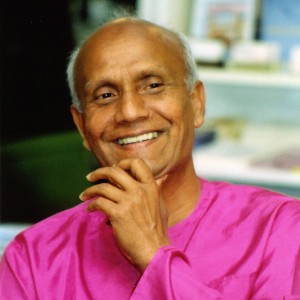If happiness would have an age it would probably be somewhere between four and seven years old. Happiness is a child’s natural possession. Unfortunately it is often an adult’s lost possession. The older we become the harder it seems to be to remain happy.
But perhaps we take age too seriously. As Sri Chinmoy, author of the Jewels of Happiness and an expert on the art of being happy, often said: “Age is in the mind and not in the heart.” Although our physical body may be advanced in years, we can easily be young in heart and spirit. And the younger we feel, the closer we are to the source of happiness inside us. Here are 5 simple ways to help you feel young:
1. Smile!
 “Smiling makes the mind young,” Sri Chinmoy wrote. A smile is one of the most effective shortcuts to feeling young. Most adults smile about 20 times a day, but children are champion smilers with an average of 400 smiles a day. The power of a smile is considerable. Scientific research has discovered that smiling boosts our immune system, lowers blood pressure and releases powerful endorphins that counter stress. It stimulates award-centers in the brain similar to eating chocolate or receiving a large sum of money. In fact, British scientists have found that one smile can trigger the same reaction in the brain as receiving 16,000 British pounds (about $25,000 or €20,000) does. Perhaps that’s why we speak about a ‘million dollar smile’.
“Smiling makes the mind young,” Sri Chinmoy wrote. A smile is one of the most effective shortcuts to feeling young. Most adults smile about 20 times a day, but children are champion smilers with an average of 400 smiles a day. The power of a smile is considerable. Scientific research has discovered that smiling boosts our immune system, lowers blood pressure and releases powerful endorphins that counter stress. It stimulates award-centers in the brain similar to eating chocolate or receiving a large sum of money. In fact, British scientists have found that one smile can trigger the same reaction in the brain as receiving 16,000 British pounds (about $25,000 or €20,000) does. Perhaps that’s why we speak about a ‘million dollar smile’.
If you’re not a regular smiler you can practice by going through the motions in front of a mirror a few times a day and trying to make your smile as genuine as possible. Visualizing a happy memory or someone you love helps to activate the smiling muscles as well.
2. Sing!
 Just like smiling, singing is another simple activity that works wonders for our happiness, health and wellbeing – all powerful parameters to feeling young at heart. People who sing regularly, either by themselves or in a choir, report feelings of joy, elation and cheerfulness.
Just like smiling, singing is another simple activity that works wonders for our happiness, health and wellbeing – all powerful parameters to feeling young at heart. People who sing regularly, either by themselves or in a choir, report feelings of joy, elation and cheerfulness.
Science has also drawn the conclusion that singing is a good thing to do, as it trains our lungs to breathe better, boosts our immune system and reduces stress. A Swedish study found that singing together, like in a choir, tends to synchronize the heartbeats of the singers, which results in a calming effect on body and mind comparable to yoga.
Like smiling singing can be done anyplace and anytime. Why save your voice only for the shower? You can sing while walking in the street, driving your car or cycling your bike. Perhaps you want to keep your voice down a little in public places, but soft singing can give the same joy as singing out loud does.
3. Exercise!
 Regular exercise keeps our body fit and also has tremendous benefits on our mental health. Mens sane in corpore sano the Romans said, meaning ‘a healthy mind in a healthy body’. Modern science seems to prove them right. A Canadian study from 1967 proved that people who exercised regularly during a period of four years or more had significantly more energy, patience, humor, ambition and optimism than a control group who had just started an exercise regime. The physically fit group also tended to be friendlier, more exuberant, cheerful and socially pleasant than the control group.
Regular exercise keeps our body fit and also has tremendous benefits on our mental health. Mens sane in corpore sano the Romans said, meaning ‘a healthy mind in a healthy body’. Modern science seems to prove them right. A Canadian study from 1967 proved that people who exercised regularly during a period of four years or more had significantly more energy, patience, humor, ambition and optimism than a control group who had just started an exercise regime. The physically fit group also tended to be friendlier, more exuberant, cheerful and socially pleasant than the control group.
Aside from the psychological benefits, regular exercise has also been shown to turn back the clock and stop aging. In 2009 scientists at the University of Saarlandes in Saarbrücken, Germany studied a group of 104 people and found that 50-year-old adults with a lifetime of strenuous exercise behind them – such as marathon runners – had a biological age that was significantly younger – sometimes decades – than their inactive peers. Exercise showed to have an anti-aging effect on the DNA of the cells. Sri Chinmoy was evidently aware of that when he wrote, “Running makes the body young.”
4. Positive thinking
 “The secret of remaining young is to devour beautiful and powerful thoughts,” Sri Chinmoy wrote. When we have positive thoughts in our mind we feel happy, light and cheerful. The burden of worries and anxieties is lifted from our shoulders and we enjoy a tangible sense of peace. Positive thinking is the basis of good mental, emotional and spiritual health. Youth means being positive, hopeful and always looking forward.
“The secret of remaining young is to devour beautiful and powerful thoughts,” Sri Chinmoy wrote. When we have positive thoughts in our mind we feel happy, light and cheerful. The burden of worries and anxieties is lifted from our shoulders and we enjoy a tangible sense of peace. Positive thinking is the basis of good mental, emotional and spiritual health. Youth means being positive, hopeful and always looking forward.
We will discover the fountain of eternal youth if we consciously cultivate positive thoughts. The most effective way to do this is to practice the techniques of concentration and meditation. By focusing our mind on a single small object, like a candle flame, for several minutes each day, we acquire the capacity to control our thoughts. [An easy to learn concentration exercise can be found here: http://www.srichinmoybio.co.uk/blog/meditation/an-easy-to-learn-concentration-exercise/]
Then we can choose to strengthen the positive thoughts inside us and steer away from the negative thoughts. And by meditating on something vast, like the sky or the ocean, we purify our mind so that positive thoughts can more easily take root.
Here are some examples of positive thoughts that empower us and keep us young:
- I am made of unconditional love and eternal happines
- I am one with my soul’s infinite peace
- I am not the mind, but I am the heart
- I am a child of the Divine, I am a child of God.
5. Have a goal
 A good friend of mine once said something very wise: ‘Happiness is a direction.’ We need something to aim at, something that drives us and gives meaning to our life. Perhaps it is running a marathon, or creating a beautiful poem or painting. Maybe it is helping or serving other people or the community we live in. When we have a goal, we are filled with enthusiasm and determination. These two qualities feed our dynamism and keep us youthful and exuberant. The moment we give up hope and surrender to failure, age starts to descends on us. But if we don’t lose sight of our goal, then our so-called failures become the pillars of our eventual and inevitable success.
A good friend of mine once said something very wise: ‘Happiness is a direction.’ We need something to aim at, something that drives us and gives meaning to our life. Perhaps it is running a marathon, or creating a beautiful poem or painting. Maybe it is helping or serving other people or the community we live in. When we have a goal, we are filled with enthusiasm and determination. These two qualities feed our dynamism and keep us youthful and exuberant. The moment we give up hope and surrender to failure, age starts to descends on us. But if we don’t lose sight of our goal, then our so-called failures become the pillars of our eventual and inevitable success.

